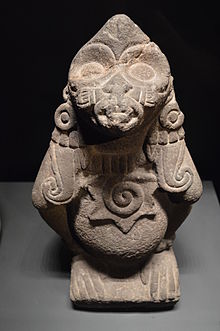Acolhua
- Machine translation, like DeepL or Google Translate, is a useful starting point for translations, but translators must revise errors as necessary and confirm that the translation is accurate, rather than simply copy-pasting machine-translated text into the English Wikipedia.
- Consider adding a topic to this template: there are already 5,027 articles in the main category, and specifying
|topic=will aid in categorization. - Do not translate text that appears unreliable or low-quality. If possible, verify the text with references provided in the foreign-language article.
- You must provide copyright attribution in the edit summary accompanying your translation by providing an interlanguage link to the source of your translation. A model attribution edit summary is
Content in this edit is translated from the existing Spanish Wikipedia article at [[:es:Acolhuas]]; see its history for attribution. - You may also add the template
{{Translated|es|Acolhuas}}to the talk page. - For more guidance, see Wikipedia:Translation.

The Acolhua are a Mesoamerican people who arrived in the Valley of Mexico in or around the year 1200 CE.[1] The Acolhua were a sister culture of the Aztecs (or Mexica) as well as the Tepanec, Chalca, Xochimilca and others.
The most important political entity in ancient Mesoamerica was the Triple Alliance (Nahuatl, excan tlatoloyan), founded in 1428 when the rulers of Tenochtitlan, Texcoco, and Tlacopan formed an alliance that replaced the Tepanec Empire of Azcapotzalco and eventually integrated into a single polity the most developed regions of western Mesoamerica. Because of the predominance of Tenochtitlan, it has also been called the Mexica, Aztec, or Tenochca Empire. It came to an end with the Spanish conquest of 1521.
Each of the three allied kings led a group of lesser kingdoms that coincided with the three major ethnic components and political powers of previous times: the Colhuas, the Acolhua-Chichimecs, and the Tepanecs. The domain of Tenochtitlan was the southern part of the Basin, with the Colhua towns of Xochimilco, and Cuitlahuac. Tetzcoco's domain comprised the Acolhua kingdoms in the eastern Basin and beyond to Tollantzinco and Cuauhchinanco. Tlacopan ruled the Tepanec towns of the western Basin, including Azcapotzalco and Coyoacán, and towns farther north to the Otomí center of Xilotepec.
These three allied groups of kingdoms constituted the core area of the empire, which as a unit then expanded its power over more distant areas.[2]
The Acolhua became the allies of the Aztecs against Tepanec.[3] The Acolhua settled most of the eastern Basin of Mexico, Acolhuacan. Their capital was Texcoco.[3]
It is likely that the ruling family of the Acolhua were descended from Otomí speakers and did not speak Nahuatl until decreed by their ruler (tlatoani) Techotlalatzin.[4]
References
- ^ Smith (1984, p.171), who arrives at this date by averaging six dates mentioned in early codices.
- ^ Carrasco, Pedro. "Triple Alliance." In Davíd Carrasco (ed.). The Oxford Encyclopedia of Mesoamerican Cultures. : Oxford University Press, 2001.
- ^ a b Evans, Susan T. (1985). "The Cerro Gordo Site: A Rural Settlement of the Aztec Period in the Basin of Mexico". Journal of Field Archaeology. 12 (1): 1–18. doi:10.2307/529371. JSTOR 529371.
- ^ Davies (1980, p.129); Smith (1984, p.170).
- v
- t
- e
- North American Pre-Columbian Cultures
- Ancestral Puebloans
- Caddoan Mississippian
- Chichimeca
- Coles Creek
- Fremont
- Hohokam
- Hopewell Tradition
- Marksville
- Mississippian
- Mogollon
- Plaquemine
- Plum Bayou
- Poverty Point
- Sinagua
- Troyville
- Weeden Island
- Mesoamerican Pre-Columbian Chronology
- Acolhua
- Capacha
- Chalcatzingo
- Cholula
- Chupícuaro
- Coclé
- Cuicuilco
- Diquis
- Epi-Olmec
- Huastec
- Izapa
- Mezcala
- Mixtec
- Nicoya
- Olmecs
- Pipil
- Purépecha
- Quelepa
- Shaft tomb tradition
- Teuchitlán
- Teotihuacan
- Tepanec
- Tlatilco
- Tlaxcaltec
- Toltec
- Totonac
- Veracruz
- Veraguas
- Xochipala
- Zapotec
- Andean Civilizations
- South American Indigenous People
- Cultures of Pre-Cabraline Brazil
- Cultures of Pre-Columbian Bolivia
- Cultures of Pre-Columbian Chile
- Cultures of Pre-Columbian Colombia
- Cultures of Pre-Columbian Ecuador
- Cultural Periods of Peru
- Cultures of Pre-Columbian Venezuela
- El Abra
- Atacameño
- Aymara
- Calima
- Cañaris
- Caral-Supe
- Casma–Sechin
- Chachapoya
- Chancay
- Chango
- Chavín
- Chimú
- Chinchorro
- Chiripa
- Diaguita
- Gran Chaco
- Huetar
- Kuhikugu
- Hydraulic Culture of Mounds (Bolivia)
- Las Vegas
- La Tolita (Tumaco)
- Lima
- Lupaca
- Luzia
- Manteño-Huancavilca
- Marajoara
- Mapuche
- Moche
- Mollo
- Monte Verde
- Nariño
- Nazca
- Omagua
- Piaroa
- Pucará
- Pucará de Tilcara
- Quebrada de Humahuaca
- Quimbaya
- San Agustín
- Shuar
- Sican
- Taíno
- Tairona
- Tierradentro
- Timoto–Cuica
- Tiwanaku
- Toyopán
- Valdivia
- Wankarani
- Wari
- Zenú
See also | |
| |
 Civilizations portal Civilizations portal |











